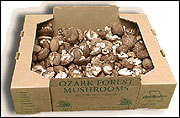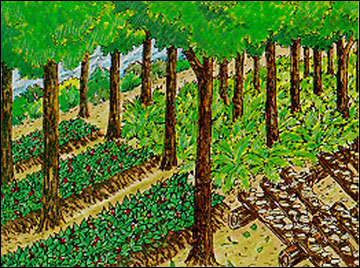 Editor's note
Editor's note
The following abstract describes a publication that is only available as a downloadable PDF.
Cultivating shiitake mushrooms represents an opportunity to utilize healthy low-grade and small-diameter trees thinned from woodlots as well as healthy branch-wood cut from the tops of harvested saw-timber trees. When the mushrooms are collected and marketed, the result is a relatively short-term payback for long-term management of wooded areas.
The cultivation of shiitake mushrooms on solid wood requires a significant amount of shade and wind protection, but not a significant amount of acreage. Therefore it is an excellent opportunity for landowners with smaller acreages to utilize forested or shaded areas. Shiitake producers can often obtain wood for cultivation from land management agencies or private landowners. In addition to making productive use of woodlots and forested acres, logs that have been used for shiitake production, called "spent" logs, can be ground and recycled as compost or used as a fuel and heat source for winter mushroom production.
Shiitake mushrooms can be grown indoors or outdoors on almost any deciduous wood that retains its bark for a number of years. When shiitake are cultivated outdoors on logs in a managed shade environment, a forest farming practice is initiated.
The practice of intentionally managing shade levels in a forest to favor the production of certain crops represents the agroforestry practice called forest farming. Properly applied, forest farming can enhance and diversify income opportunities, while at the same time improving the composition and structure of the forest for long-term stand health, quality and economic value. By developing an understanding of the interactions between the overstory trees and the understory environment, forest management activities can be used to create understory sites ideal for growing profitable shade-loving crops like shiitake mushrooms.
 In this forest farming practice, shiitake are grown on logs under the shade of trees. Additional forest farming crops, like ginseng or ferns, can also be cultivated in the same setting.
In this forest farming practice, shiitake are grown on logs under the shade of trees. Additional forest farming crops, like ginseng or ferns, can also be cultivated in the same setting.
Topics
- Long term tree crops
- Short term understory crops
- Forested land
- Healthier forest environment
Pages
- 16